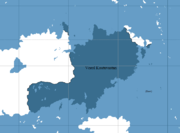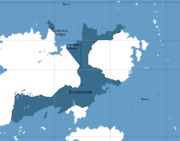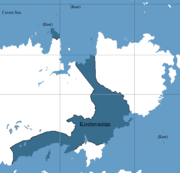Difference between revisions of "Kostuvastan"
Tuvaltastan (Talk | contribs) (→Molgov Dynasty (1352-1786)) |
Tuvaltastan (Talk | contribs) (→Alvonic Dynasty (1214-1352)) |
||
| Line 21: | Line 21: | ||
====Alvonic Dynasty (1214-1352)==== | ====Alvonic Dynasty (1214-1352)==== | ||
| + | This dynasty consisted of many isolationist monarchs who, for a century (1247-1347), halted all foreign relations. It took the Molgov Dynasty monarchs another century and a half to restore relations with the neighboring states. | ||
====Molgov Dynasty (1352-1786)==== | ====Molgov Dynasty (1352-1786)==== | ||
Revision as of 22:58, 22 January 2017
Kostuvastan was a nation that stretched throughout the middle of Aurora, and was separated after its civil war. It bordered the countries Caltharus and Ethalria. The nation was replaced by the nations Tuvaltastan, Tivot, Kostromastan, and Baykalia, and is the successor to the Kostuvian Empire.
Contents
History
Dynastic Kostuvastan (12-1894)
To start off, a dynasty is defined by when the last name of the King or Queen is changed, the offspring of a dynasty change their last name, or a major revolution occurs.
Slovin Dynasty (12-396)
After being founded in 12 A.D. (See Kostuvian Empire) by the first King, Rorik von Slovinich, Kostuvastan was weak and few people within the nation co-operated with each other. The northern-most peoples in Kostuvastan ran most of the governmental and military operations, while the rest focused on subsistence farming, so as to produce enough food for their families. The infrastructure of Kostuvastan was established during this dynasty, and the first mailing system was created, albeit a very crude one. This mailing system refined itself over millennia, and directly evolved into the now highly-efficient Kostro Postal Service, Tivo Postal Service, Baykal Postal Service, and Tuvalt Postal Service. Along with the postal service, the well-maintained road system that connects Kostromastan, Tuvaltastan, and Baykalia, as well as parts of Caltharus and Ethalria, was proposed during the Slovin Dynasty, and was established during the Qurala Dynasty.
Wolon Dynasty (396-827)
Jeoffery Wolonovich, formerly known as Jeoffery Slovinich, was the son of King Rorik IV, and was basically a rebellious teenager who did not want to be in the same dynasty has his father, and changed his name in order to do so. If Jeoffery Wolonovich did not change his last name, it would be very likely that the Slovin Dynasty would be much longer. The Wolon dynasty ironically followed in the footsteps of the Slovin Dynasty, and had a very similar industrious nature to the Slovin Dynasty.
Lewin Dynasty (827-895)
Rorik Lewinski was the only king in this dynasty, and was not very liked. Quite gluttonous, Lewinski exploited his kingdom through taxes and became the richest Kostuva King ever. This wealth resulted in Lewinski being beheaded via Rotary Guillotine, along with his three sons, leaving Lewinki's daughter the throne. Lewinski died at the age of 106, making him the oldest monarch in Kostuvastan.
Qurala Dynasty(895-1214)
(Main article: Qurala Dynasty)
Beatrice Quralanolovich, who changed her last name to be as different from her father's last name so as to remove all connections with him, was the first Queen of Kostuvastan, and never married. Extremely liked, Quralanolovich removed all the unneccessary taxes inflicted upon the public by her father, and grew the economy by establishing trade routes with neigboring Ethalria, Dragonia, and Staynes. With no heir, due to Beatrice being sterile, and with no other family member willing to take the throne, Beatrice adopted a son, who became the root of the rest of the royal family tree.
Alvonic Dynasty (1214-1352)
This dynasty consisted of many isolationist monarchs who, for a century (1247-1347), halted all foreign relations. It took the Molgov Dynasty monarchs another century and a half to restore relations with the neighboring states.
Molgov Dynasty (1352-1786)
The Molgov Dynasty is the longest-running dynasty in Kostuva history, and was the longest-running due to every monarch's charisma, experience, and overall amicable nature. Taking the economic policies of the Qurala Dynasty, and the industriousness of the Wolon and Slovin dynasties, the Molgov Dynasty improved every aspect of the Kostuva way of life. These centuries of prosperity eventually led to the invention of the Auralgraph and the steam engine in later years.
Vorolov Dynasty (1786-1792)
Like the Lewin Dynasty, the Vorolov Dynasty only had a single monarch, named Rorin Vorolov. Known as Rorin the Terror, Vorolov killed millions, but the exact number is unknown. Estimates range from as little as 2,000,000 to as much as 15,000,000. Nonetheless, Vorolov and his army attempted to conquer Aurora, but only managed to take the area west of the Kalivian mountains and beyond, due to the Morstaybishlian Empire protecting the areas north of the lakes in the southwest of Kostuvastan.
Democratic Dynasty (1792-1894)
Due to the tyranny of the Vorolov Dynasty, the Kostuv People overthrew the monarchy and established a Democratic System of determining the King. Each King served until their death, and a new King would be elected. Only three Kings were elected this way, because the people of Kostuvastan established a new system of government. During this dynasty, the Baykalian people attempted to secede from Kostuvastan. They managed to secede, and Caltharus and Kostuvastan both attempted to annex the territory. After Baykalia suffered extreme poverty for five years, Baykalia willingly chose to be annexed by Kostuvastan, at the frustration of many Caltharians.
Post-Imperial Kostuvastan (1894-1985)
(Main article: Post-Imperial Kostuvastan)
Auroran War
From the beginning to the middle of the 1970's, Kostuvastan was on the Empirical side of The Auroran Imperial War.
Cultural Clashes
During the last three decades before the Kostuvastan Civil War, the Baykalian minority in the country had near-total control of the country.




